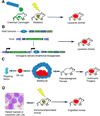Animal models of leukemia: any closer to the real thing?
- PMID: 23081702
- PMCID: PMC3568447
- DOI: 10.1007/s10555-012-9405-5
Animal models of leukemia: any closer to the real thing?
Abstract
Animal models have been invaluable in the efforts to better understand and ultimately treat patients suffering from leukemia. While important insights have been gleaned from these models, limitations must be acknowledged. In this review, we will highlight the various animal models of leukemia and describe their contributions to the improved understanding and treatment of these cancers.
Figures

Similar articles
-
Modeling ETV6-JAK2-induced leukemia: insights from the zebrafish.Haematologica. 2012 Dec;97(12):1783-5. doi: 10.3324/haematol.2012.080754. Haematologica. 2012. PMID: 23204479 Free PMC article. No abstract available.
-
Zebrafish Models of Human Leukemia: Technological Advances and Mechanistic Insights.Adv Exp Med Biol. 2016;916:335-69. doi: 10.1007/978-3-319-30654-4_15. Adv Exp Med Biol. 2016. PMID: 27165361 Free PMC article. Review.
-
The zebrafish as a tool in leukemia research.Leuk Res. 2012 Sep;36(9):1082-8. doi: 10.1016/j.leukres.2012.06.001. Epub 2012 Jun 27. Leuk Res. 2012. PMID: 22749067 Review.
-
Leukemic transformation in patients with severe congenital neutropenia.J Pediatr Hematol Oncol. 2001 Nov;23(8):487-95. doi: 10.1097/00043426-200111000-00005. J Pediatr Hematol Oncol. 2001. PMID: 11878775 Review. No abstract available.
-
Investigating human leukemogenesis: from cell lines to in vivo models of human leukemia.Leukemia. 2008 Nov;22(11):2029-40. doi: 10.1038/leu.2008.206. Epub 2008 Aug 7. Leukemia. 2008. PMID: 18685615 Review.
Cited by
-
Identifying novel therapeutic agents using xenograft models of pediatric cancer.Cancer Chemother Pharmacol. 2016 Aug;78(2):221-32. doi: 10.1007/s00280-016-3042-6. Epub 2016 May 18. Cancer Chemother Pharmacol. 2016. PMID: 27193096 Free PMC article. Review.
-
Comparative utility of NRG and NRGS mice for the study of normal hematopoiesis, leukemogenesis, and therapeutic response.Exp Hematol. 2018 Nov;67:18-31. doi: 10.1016/j.exphem.2018.08.004. Epub 2018 Aug 17. Exp Hematol. 2018. PMID: 30125602 Free PMC article.
-
Nanoparticles-Emerging Potential for Managing Leukemia and Lymphoma.Front Bioeng Biotechnol. 2017 Dec 18;5:79. doi: 10.3389/fbioe.2017.00079. eCollection 2017. Front Bioeng Biotechnol. 2017. PMID: 29326927 Free PMC article. Review.
-
Establishment of CD34 + hematopoietic stem cell-derived xenograft model of hyperleukocytic acute myeloid leukemia.BMC Cancer. 2025 Mar 18;25(1):499. doi: 10.1186/s12885-025-13907-5. BMC Cancer. 2025. PMID: 40102796 Free PMC article.
-
Autophagy limits proliferation and glycolytic metabolism in acute myeloid leukemia.Cell Death Discov. 2015 Aug 17;1:15008-. doi: 10.1038/cddiscovery.2015.8. Cell Death Discov. 2015. PMID: 26568842 Free PMC article.
References
-
- Siegel R, Ward E, Brawley O, Jemal A. Cancer statistics, 2011: The impact of eliminating socioeconomic and racial disparities on premature cancer deaths. CA Cancer J Clin. 2011;61:212–236. - PubMed
-
- Gilliland DG, Jordan CT, Felix CA. The molecular basis of leukemia. Hematology Am Soc Hematol Educ Program. 2004:80–97. - PubMed
-
- Licht JD, Sternberg DW. The molecular pathology of acute myeloid leukemia. Hematology Am Soc Hematol Educ Program. 2005:137–142. - PubMed
-
- Lowenberg B. Acute myeloid leukemia: the challenge of capturing disease variety. Hematology Am Soc Hematol Educ Program. 2008;2008:1–11. - PubMed
-
- Dohner H, Estey EH, Amadori S, et al. Diagnosis and management of acute myeloid leukemia in adults: recommendations from an international expert panel, on behalf of the European Leukemia Net. Blood. 2010;115:453–474. - PubMed
Publication types
MeSH terms
Grants and funding
LinkOut - more resources
Full Text Sources
Other Literature Sources
Medical

